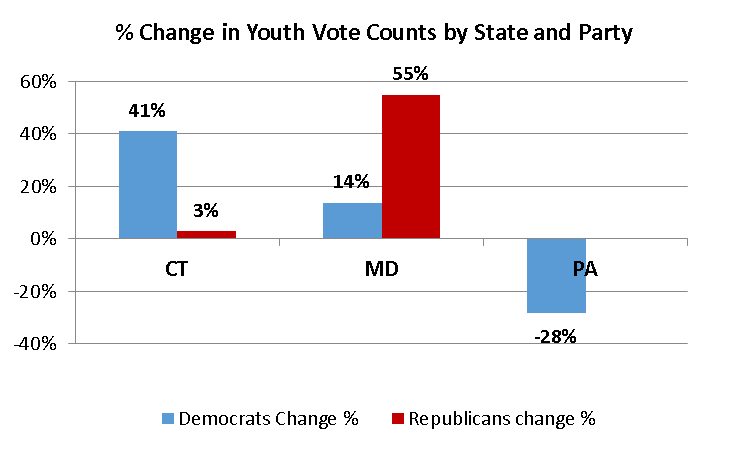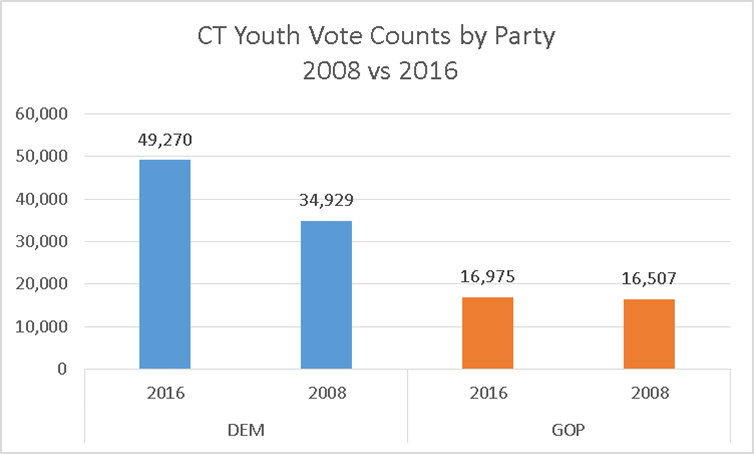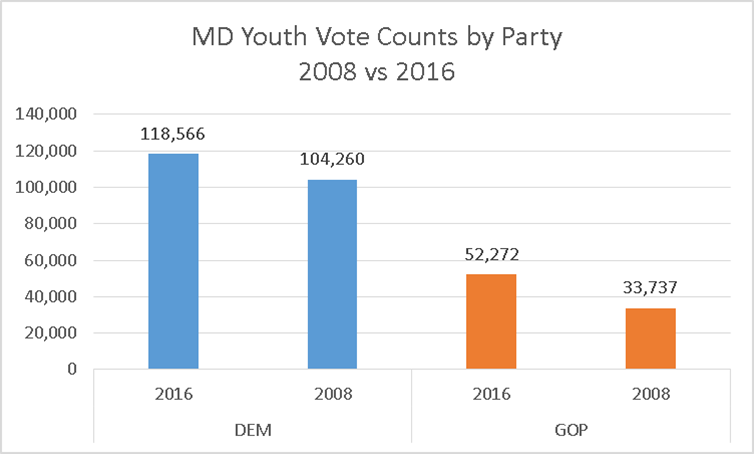High Youth Turnout Continues in Maryland, Connecticut; Young Voters Still Lukewarm on Frontrunners
The pattern of high youth participation in the 2016 primaries continued yesterday, especially in Connecticut and Maryland,[1] while youth participation may have decreased in the Pennsylvania Democratic primary. Different patterns of youth voting played out in each of the three states, but one dynamic was consistent among all three: young people continue to favor the party frontrunners to a lesser degree than older voters.
Connecticut
The estimated youth turnout in Connecticut matched the previous record of 12% set in 2008. However, the number of young people who cast their ballot increased, as did the youth share of all voters: from 10% in 2008, to 12% in 2016. Youth participation was driven primarily by young Democratic primary voters; overall, 49,000 young Democrats went to the polls, compared to 17,000 young Republicans.
On the Democratic side, young voters preferred Senator Sanders over Secretary Clinton, 83% to 17%, according to the Edison Research exit poll. Sanders also won the majority of support of 30-44 year olds but not the oldest two age groups. As in previous races this election season, extremely strong youth support kept the contest closer and may have led to Sanders receiving more delegates. On the Republican side, youth participation matched that of 2008, but the sample size of young voters in the exit poll was too small to estimate candidate support.
Maryland
In Maryland, an estimated 18% of youth, ages 17-29, participated in yesterday’s primary, meaning over 170,000 young people cast ballots. Both the turnout and vote count were higher than in 2008.
The state saw growth in youth participation in both party primaries, but the increase was more dramatic in the Republican primary. An estimated 52,000 young people cast their ballots in that contest, more than doubled the estimate for 2012 (19,000) and surpassing the previous record (49,000) from 2000.
Young people in the Republican primary split their votes across the three candidates almost equally. Donald Trump received 33% of youth votes in Maryland, while Senator Cruz received 32% and Governor Kasich 31%.
The Democratic primary was different, however, as Senator Sanders received 68% of youth support, which was the only age group he won in the state. Sanders’ loss with voters in their 30s and his relatively modest win with young people in Maryland—compared to his 70%-80% support from youth in other contests—may be due to the state’s demographics. African Americans made up almost half of voters (46%) in Maryland’s Democratic primary, and young African Americans have shown more support for Secretary Clinton than other youth so far this year.
Pennsylvania
We estimate that over 350,000 youth in Pennsylvania participated in yesterday’s primaries, (18% of the young citizen population in the state), making up 11% of all voters. Almost 200,000 young people participated in the Democratic primary, less than in 2008, while more than 150,000 participated in the Republican contest. Unlike in Maryland, where twice as many young Democrats voted than young Republicans, and in Connecticut, where three times as many youth voted in the Democratic than in the Republican contest, in Pennsylvania the number of youth votes were more evenly distributed between both parties.
Young people strongly preferred Senator Sanders in the Democratic primary. In the Republican contest, Donald Trump won 52% of the youth vote, his highest total in any state so far, even though young people still supported him less than older voters.
A perennial general election battleground, Pennsylvania is one of the states to watch this November according to our Youth Electoral Significance Index (YESI), which ranks the top-10 states and congressional districts where young people can potentially have a decisive impact in the 2016 election. Pennsylvania ranks 2nd in our YESI for the Senate race there, and 2nd for the presidential contest.
For regular updates in your Inbox about youth and the 2016 election,
sign up for CIRCLE’s
monthly E-Update here.
[1] While five primaries occurred on April 26, only three exit polls were conducted (CT, MD, PA). There is no comparison data for the overall Pennsylvania youth turnout, as there was no Republican exit poll in 2008 PA primary.











